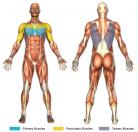Flys (Dumbbell)
- Set a bench to a flat position.
- Sit and grasp a dumbbell in each hand, resting each atop its respective knee.
- Slowly lie backward onto the bench, while concurrently moving the dumbbells from your knees to a supported position at your sides, and then press them up until your arms are nearly extended. This is the starting position. The dumbbells should be grasped with a neutral grip (i.e. with your palms facing one another).
- Slowly lower the dumbbells outward to your sides--keeping your arms slightly bent--until your arms are parallel with the ground (horizontal), inhaling throughout the movement.
- Raise the dumbbells until they nearly meet at the top (above your chest), exhaling throughout the movement.
- Repeat steps 4-5 for as many repetitions as are desired.
When the arms are together above the chest that the inner chest (sternal head) is most optimally contracted. If your aim is to work the inner aspect of the chest, then pay extra attention to the squeeze at the very end of the positive motion (where the arms meet above your chest). Isometrically contract your chest muscles to achieve full sternal head muscular recruitment, i.e. hold the squeeze briefly before you begin to lower for the next repetition. There is no need to clank the dumbbells together to achieve full isometric contraction.
The fully-stretched, back (extended) aspect of the motion is where the outer chest is most optimally contracted. If your aim is to work the outer aspect of the chest, then pay extra attention to the stretch at the very end of the negative motion (where the arms are back). Do note, however, that both the pectorals and anterior deltoids are particularly vulnerable to injuries when in this position.
Pec dec flys work the pectoralis major muscles (i.e. the main, large chest muscles), to include both the sternal head (i.e. inner aspect) and the clavicular head (i.e. primarily the upper aspect of the chest, but also the upper-outer aspect). In addition to working the pectorals, this exercise works the coracobrachialis and the short head of the biceps.
The negative aspect (when the arms are outstretched to the sides and back) is conventionally considered a hazardous aspect of any sort of fly exercise, and this is especially so for dumbbell flys due to the free range of motion that dumbbells give. When the arms are outstretched to the sides and back, tremendous stress is put on the anterior shoulders and pectorals, especially with heavy weight usage. Biceps injuries, though far less common, do also occur with flys. As a general rule, if not familiar with flys or if pain is felt, use good judgment and only use weight amounts that you are comfortable with. Also, do not feel obligated to fully stretch your pectorals with this exercise.





